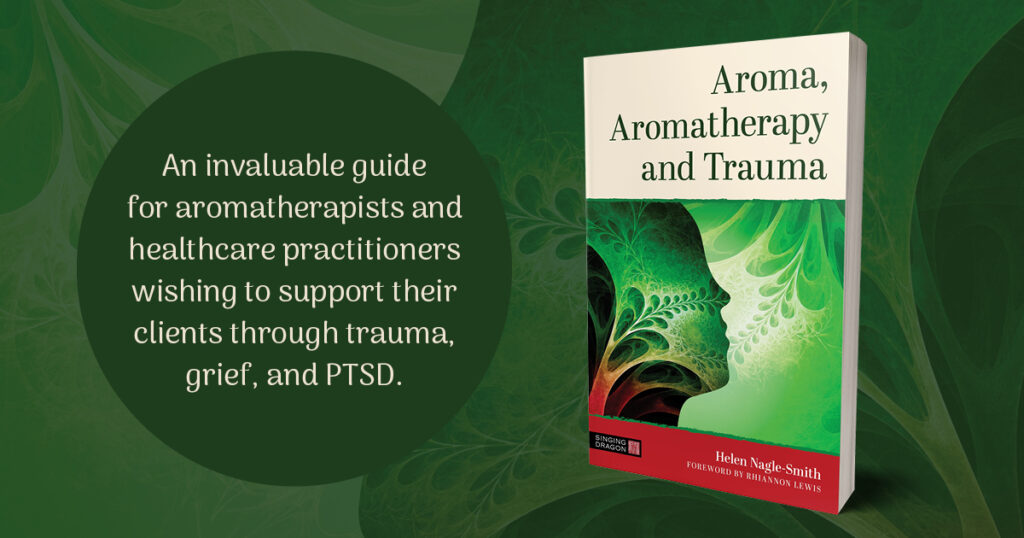Written by Helen Nagle-Smith, author of Aroma, Aromatherapy and Trauma and Working with Unusual Essential Oils.
How important is your sense of smell to you? As an aromatherapist, I really value my nose and the complex relationship between my sense of smell and brain. I understand that my olfactory bulb is closely linked to the parts of the brain that process emotions, memories and fears. In the millisecond we smell something we can have a negative or positive response. Inhaling the scent of a rose, takes me back to happy, sunny summer days as a child, playing in my garden with my sibling making rose perfume.

Unfortunately, as we live in a world dominated by auditory and visual stimulus, our sense of smell is often considered to be a ‘poor’ relation (Barwich, 2020). The difficulty with this is we often forget how our sense of smell intersects with real human issues such as trauma. We should never underestimate the terror evoked by a sudden, unexpected aroma that acts as a trigger. Research by Hinton et al. (2004) showed that of a group of 100 Cambodian refugees, 45% had experienced an odour triggered panic attack in the last month. The invisibility of aroma often means that there is no warning (Herz, 2021).
Ignoring our sense of smell when we discuss trauma, can feel invalidating for those experiencing smell triggers. It also means we fail to comprehend how aromas can be positively used and become a supportive anchor, enabling feelings of safety and comfort. Feeling safe is crucial for people who have experienced trauma.
I wrote Aroma, aromatherapy and trauma because I believe the link between olfaction and trauma should be explored in more depth, for the benefit of people who have lived experience and for the professionals seeking to support them. I wanted to raise awareness of the importance of olfaction within the world of traumatology, and in my aromatic community, I wished to continue developing the conversations around trauma.
My previous career (working in information and counselling services) and nearly twenty years’ experience as a clinical aromatherapist have shown me that trauma shows up in different ways for people. Sometimes a client seeks out aromatherapy and already has a formal diagnosis of PTSD, but most of the time this isn’t the case.
A client will disclose snippets of their history as the relationship between us develops and they realise I am a ‘safe space.’ The word trauma isn’t necessarily in their vocabulary, they are more likely to use different terminology for instance someone might say that they had a difficult childhood where they didn’t feel loved. Some clients have secondary trauma due to their work (which appears to be most common in the police, social services, fire services, national health service etc). Many clients have had a recent traumatic bereavement, sometimes following a gruelling illness for their loved one, during which their role often became redefined as carer.
Sometimes a client won’t mention anything, but during an aromatherapy massage something may happen. Their body might involuntarily tremble, shudder or shake, they may tense up, start crying, wailing or weeping. They may have a flashback or start talking about an incident or person. The effects of it can be profound for their mind, body and soul, and we have a responsibility to respond in a trauma-informed way.
Whilst I was researching my latest book, I wanted to go beyond the research and my clinical work, so I talked to approximately twenty aromatherapists around the world in more detail. I was impressed with the variety of ways they were supporting clients who had been through trauma. Many would use essential oils or hydrolats that evoked pleasant memories. Aromatherapist Natascha Köhler who has worked in a refugee camp told me that “one drop of lemon (essential oil) for the children gives a thousand smiles.”
As aromatherapists, these colleagues also knew how to harness the biological, clinical and therapeutic effects of their aromatics too, thus adding another layer of support that entwines with the pleasant association. For example, Denise Cusack told me “Therapeutically, rose is used during times of physical and emotional stress, soothing and calming both the mind and body.” For the refugees she was working with, it was also a familiar comforting aroma of home, food, culture and traditions.
Aroma, aromatherapy and trauma is a trauma-informed blend of science, research, practical advice, case studies and information on aromatherapy. It is suitable for both professionals and those who are on their own journey with trauma and demonstrates how aroma and aromatherapy can be a powerful ally.
You can purchase Helen’s books via the Singing Dragon website and other major book retailers.
Barwich, A.S. (2020) Smellosophy. Cambridge, MA: Harvard University Press.
Herz, R. (2021) Olfactory virtual reality: a new frontier in the treatment and prevention of posttraumatic stress disorder. Brain Science, 11(8).
Hinton, D.E., Pich, V., Chhean, D., Pollack, M.H., Barlow, D.H. (2004) Olfactory triggered panic attacks among Cambodian refugees attending a psychiatric unit. General Hospital Psychiatry. 26(5), 390-397.